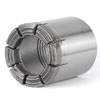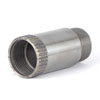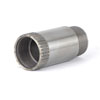Guidelines
Product Selection General Info
This section describes the general attributes of IDP's range of drilling products including: the different types of core drilling bits, their ranges of application, the optional features that may be specified for use in special conditions, the standard methods of product identification and packaging as well as health and safety issues that may arise from the use of these products.
Type of Core Bits:
There are few basic types of abrasive cutting media used in the construction of core drilling bits, each of which has its own specific range of application based on the characteristics of the formation to be drilled. The two types of core drilling bits are: Impregnated diamond type, surface-set diamond type.
Application Range :
Each of the three types of mineral exploration bits (impregnated diamond, surface-set diamond, and Tungsten-Carbide set) has an appropriate range of application. The various numerical values that are used to describe the geological formations called out in the application range chart above are defined as follows :
DCDMA Code is a reference number that is used as a comparison between different manufacturers coding systems for impregnated diamond core bits.
Moh's Hardness is a method of quantifying the hardness of geological materials by means of a simple "scratch test". The units of hardness are expressed as numbers ranging from 1 to 10, each of which is represented by a mineral that can be made to scratch any other mineral bearing a lower number. In ascending order of hardness, the minerals are ranked as follows: Talc (1), Gypsum (2), Calcite (3), Fluorite (4), Apatite (5), Orthoclase (6), Quartz (7), Topaz (8), Corundum (9) and Diamond (10).
UCS (Uniaxial Compressive Strength) is a test that is generally performed in a laboratory and is a measurement of the ultimate compressive stress that a sample of rock can withstand before failure under an increasing point load. This test is an objective means of quantifying the hardness of a geological material and therefore its drillability.






